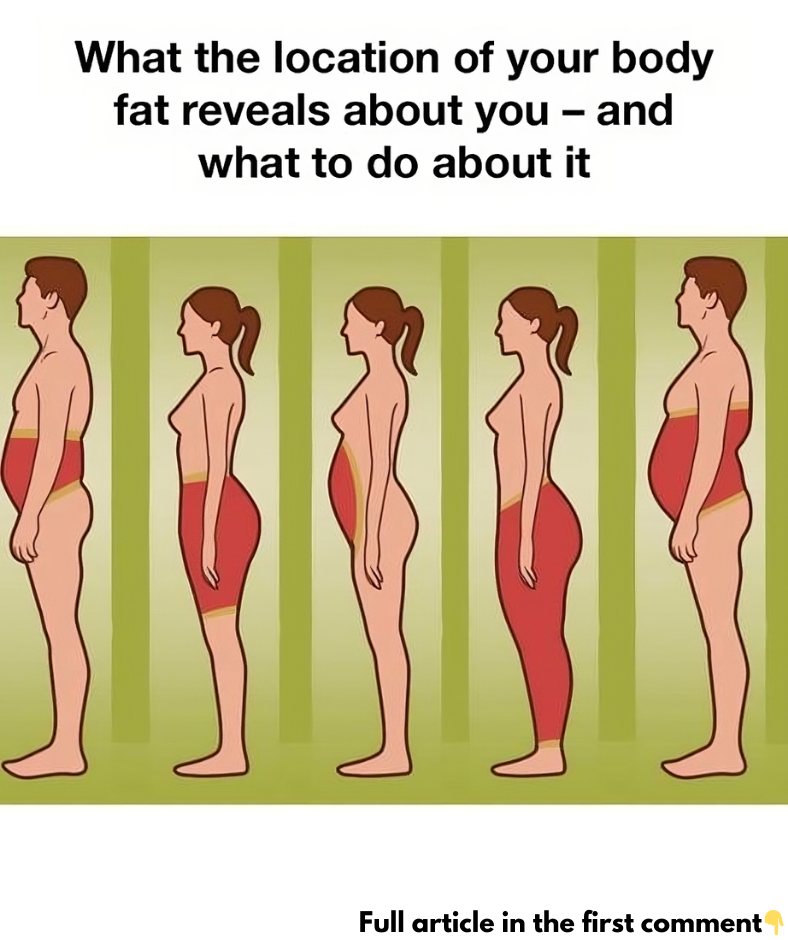What Your Body Fat Location Says About Your Health—and How to Manage It
Body fat distribution isn’t just about appearance; it can reveal a lot about your overall health. Where your body stores fat can indicate potential risks for conditions like heart disease, diabetes, and metabolic disorders. Factors like genetics, hormones, lifestyle, and diet all play a role in where fat accumulates, and understanding your body fat distribution can help you take targeted steps to improve your health. Let’s explore what the location of your body fat says about your health and how you can take action to manage it.

Why Body Fat Distribution Matters
Not all fat is the same. The location of fat on your body has a significant impact on your health. Visceral fat, which surrounds internal organs, is more dangerous than subcutaneous fat, which sits under the skin. Recognizing where your fat is stored can guide your approach to making lifestyle changes that improve your overall health.
Upper Body Fat (Apple Shape)
If you carry most of your fat around your abdomen, chest, and back, you have an “apple shape.” People with this fat distribution are more likely to store visceral fat, which surrounds vital organs in the abdominal area. This type of fat is linked to serious health problems like type 2 diabetes, insulin resistance, and heart disease.
To reduce upper body fat, focus on:
- Cardiovascular exercises like running, cycling, or swimming to burn calories and reduce overall body fat.
- Strength training targeting the core and upper body to tone muscles and boost metabolism.
- A balanced diet rich in lean proteins, whole grains, and healthy fats while limiting sugary and processed foods.
Lower Body Fat (Pear Shape)
Those who store excess fat in the hips, thighs, and buttocks are often categorized as having a “pear shape.” While lower body fat carries less risk than upper body fat, it can still cause issues like joint pain or varicose veins due to the added weight on the legs.
To manage lower body fat:
- Aerobic exercises such as walking, running, or cycling to burn fat in the lower body.
- Leg-focused strength training with lunges, squats, and other exercises to tone muscles in the hips and thighs.
- A diet centered around whole foods, lean proteins, and low-glycemic carbs to support fat loss.
Total Body Fat (Overweight/Obese)
When fat is distributed more evenly across the body, it can indicate being overweight or obese. This increases the risk of various health problems, including high blood pressure, cardiovascular disease, and diabetes.
To reduce overall body fat:
- Calorie monitoring to reduce caloric intake and make healthier food choices.
- Consistent physical activity incorporating both cardio and strength training to burn calories and build muscle.
- Behavioral therapy or support for emotional and psychological aspects of weight loss, if needed.
Visceral Fat: The Most Dangerous Fat
Visceral fat is stored deep in the abdomen, wrapping around organs like the liver and pancreas. It’s the most harmful type of fat because it contributes to chronic inflammation, raising the risk of conditions like cardiovascular disease, type 2 diabetes, and certain cancers.
To reduce visceral fat:
- High-intensity interval training (HIIT), which elevates your heart rate and burns more fat in less time.
- A low-carb, low-sugar diet to stabilize insulin levels and manage fat storage.
- Stress management to lower cortisol levels, which contribute to visceral fat. Yoga, meditation, and breathing exercises can help reduce stress.
Subcutaneous Fat: The Visible Fat
Subcutaneous fat is the fat stored just beneath the skin, the kind you can pinch. While less dangerous than visceral fat, having too much subcutaneous fat can still lead to obesity-related health problems.
To reduce subcutaneous fat:
- Cardio exercises like biking, running, or swimming to burn fat.
- Strength training to build muscle, which helps increase metabolism and reduce fat under the skin.
- Portion control and balanced diet with nutrient-dense foods to manage fat levels.
How to Manage Body Fat
Knowing where your body fat is stored can provide valuable insight into your health and help you develop a personalized plan for fat loss:
- Exercise regularly with a mix of cardio and strength training.
- Eat a balanced diet that includes whole foods, lean proteins, and healthy fats.
- Stay hydrated, as proper hydration supports fat metabolism.
- Get enough sleep, which helps regulate hunger hormones and fat storage.
- Manage stress, as high stress levels can lead to increased fat storage, especially visceral fat.
The location of your body fat offers important clues about your health risks and the steps you can take to manage them. From visceral fat, which poses the highest health risks, to subcutaneous fat, which is visible under the skin, understanding where your fat is stored can help you make informed decisions about your fitness and health goals. With regular exercise, a balanced diet, stress management, and proper sleep, you can effectively reduce body fat and improve your overall health.





